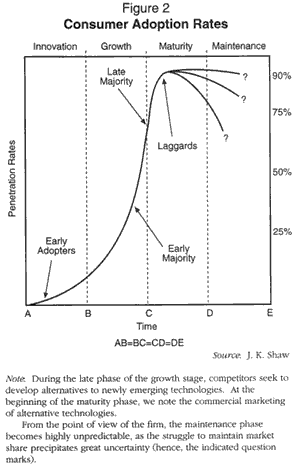
Despite this daunting task, we cannot plan unless we have a sense of where the telecommunications industry is headed. In defining a set of scenarios, the author does not presume that one scenario is intrinsically more probable than another, he merely contends that forces presently in place have impelled both the industry and economy to move along a path which isolates the following outcomes as most likely. In the end, the status of the industry in the year 2007 will, most probably, be a function of the assimilated legal, regulatory, political, technological, and organizational dynamics presently installed. It is on this basis that we are permitted the opportunity to project the future.
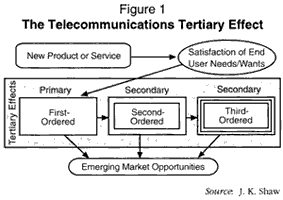
The model identifies the unfolding market effects of telecommunications innovation. When a new product is introduced, serving its constituency, we immediately note a primary tertiary effect unintended at the time. For example, the development of network television effectively created first-order tertiary effects: New sales and maintenance professions, along with support services required to sustain them, were immediately necessitated by the innovation. A second-order tertiary consequence (all consequences precipitated by the primary effect are categorized as secondary) was the impact felt by the motion picture industry: The audience for film was reduced by a factor of two-thirds in less than a decade.1 The commercial success of television and its resultant tertiary impact on enterprises immediately outside its own domain represented an unintended, and thus unpredicted, consequence. A third-order effect prompted by the rapid expansion of television was the restructuring of the advertising industry, a phenomenon that reorganized corporate planning and promotion in all industries. By implication, we also infer fourth-order, fifth-order, and sixth-order tertiary consequences, and so forth.2 Technological innovation influences every layer of organizational life, both public and private.
The importance of tertiary effect analysis, as applied to the telecommunications industry, lies in its identification of prospective market change. With the release of every successful communications product or service, we note the emergence of new market opportunities. Significantly, telecommunications has become the dominant engine of change in an economy marked by an expanding service sector. The generation, exchange, and evaluation of information will increasingly define success -- individual and organizational. The evolution of telecommunications thus provides the framework for future economic change.
A standard market research tool designed to estimate future demand for goods and services is the consumer S-curve. The S-curve, applied to prospective household and business behavior, identifies the stages of developing demand for new products. An extension of the logic implicit in Figure 2, the consumer S-curve holds that "early adopters," responsible for initial household penetration rates of 10%, dictate the fate of new technologies. A critical demographic link in the success of newly-introduced products is the influence of early adopters. Early adopters are those who, by nature, are experimental, curious, and trend-setting. We note that the unfolding pattern of a consumer S-curve is the behavior of these early adopters; no other consumer will purchase new products in the absence of the influence of those whose lifestyle and income permit such experimentation. Using the consumer S-curve, substantiated by cyclical economic evidence, we infer the patterns shown in Figure 2 with regard to household and organizational adoption.

The data repeatedly indicate that Americans are prepared to pay for information that uniquely serves their needs, enhances their productivity, and allows them to spend time on matters of "felt need." These felt needs may be as simple as spending more time with family, or as concrete as improving professional efficiency. Forty years ago, marketers geared their strategy to the segmentation of consumers by virtue of generalized demographic analysis. In the 1970s and 1980s, the strategy shifted to niche marketing, in which those same demographics were measured against emerging consumer tastes via an expanded array of segments. Today, as we assess new product development in all markets, it has become clear that niche marketing has given way to particle marketing. The object of market research has become the satisfaction of consumer tastes on an individual basis. Each consumer thus represents a new market. These markets can change suddenly, dramatically, and unpredictably.3
The implications of these broad demographic movements, and their impacts on prospective marketing, are profound and crucial to the success of telecommunications firms in this age of deregulation. You will note differences in how the five basic paradigms outlined below respond to the changing character of American society, but every model factors into its imprint the great change implicit in these trends. By 2007, business success will be defined by those firms that can make the difficult and delicate transition to particle marketing.
A few final macroeconomic and demographic facts should be contemplated before we proceed to an evaluation of emerging scenarios for the industry 10 years hence. First, as the baby boom generation ages, produces children, endures an increased debt burden, and seeks relief from the time constraints of daily living, we are likely to see the most success for those telecommunications firms that are able to "bundle" their services.4 In essence, firms that can merge telephony with television, Internet, and other services will secure a rising fraction of the market. Evidence is mounting that "boomers," the single largest generation in American history, seek a simplified menu at competitive rates.
Second, a contentious but nevertheless credible, scenario for the American economy suggests a period of rising prosperity between 1997 and 2007. Consider, for example, the following facts:5
C + I + G + Ex - Im = GDP
where C = consumers, I = business investment, G = government, Ex = exports, Im = imports. Gross domestic product is thus a function of consumer spending combined with business investment and capital spending. Government spending, when added to exports (and the overseas wealth they generate) but adjusted for imports (income and savings departing the country in the name of consumption), dictates national wealth. Viewed in their totality, the macroeconomic data suggest an expanding capacity for future savings and investment, particularly as boomers approach retirement.
These facts, however interpreted, suggest a more positive general economic environment than often outlined by economists. We must approach any serious discussion of economic modeling, however, with a set of assumptions. These assumptions must be consistent with the empirical evidence that directly bears on consumption for telecommunications services. Armed with these facts and assumptions, five discrete scenarios can be outlined for the telecommunications industry through the year 2007. These scenarios are:
The Service Explosion Model, in which the dream of deregulation, framed by the authors of the Telecommunications Reform Act (TRA), achieves a full flowering. It is a scenario in which rising demand for telecommunications products and services is met with an ever-increasing number of providers able to deliver state-of-the-art services.
Corporate Consolidation Model, a scenario greatly feared by proponents of the TRA, in which initial deregulation inevitably promotes oligopolistic restructuring in a manner reminiscent of airline deregulation since 1978.
Customer-Led Customization Model, a scenario suggesting that, while the initial years of the TRA will lead to an array of products and services dictated by corporate research and development, it will be the consumer that eventually determines the emerging shape of innovations to come.
Price Implosion Model, a nightmare for telecommunications firms, in which prices collapse as a function of constant technological innovation and rapid substitution of veteran product lines. Under the terms of this vision, profits are so diminished that no firm has an incentive to maintain existing infrastructure. Also, new product development is stifled because of inadequate wireline maintenance.
Short-Run Chaos (SRA)/Long-Run Stability (LRS) Model, in which turmoil for the remainder of this decade inevitably invites economic stability during the first decade of the next century. This model presumes that public utilities will eventually assume infrastructure responsibilities formerly the domain of telephone monopolies.
If one assumes that the future of telecommunications during the coming decade will largely be a function of the Telecommunications Reform Act, reinforced by accelerating technological change, we can project these five alternative visions. It is essential to bear in mind that a hybrid of two or more of these models could emerge in response to dynamic competitive forces.
If the framers of the 1996 act are correct in their assumptions about present competitive forces -- and the innovations likely to come from firms seeking to enter diversified markets -- we can conclude that, within the next several years, we will experience a rapid increase in the supply of telecommunications goods and services. This is an industry in which there is little point in dichotomizing product from service. Services cannot exist in the absence of infrastructure to support them, and product development will not be initiated in the absence of projected consumer demand for such services. With this reality in mind, TRA authors envisioned a simple scenario in which the forces of supply and demand would consistently reduce the price of emerging telecommunications goods and services (see Figure 3A).7
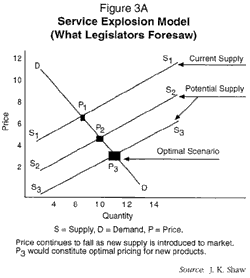
In a utopian scenario, supply would constantly expand relative to demand, precipitating gradual and, in some cases, profound reductions in price. A majority of legislators contended that constant innovation in the telecommunications industry would precipitate rapid substitution of veteran product lines in favor of new, cheaper substitutes. Indeed, these innovations would be spurred by entrants from peripheral industries. Some government officials and industry players concluded that, because the legislation permitted "entry" by any competitor, expansion of supply in the short run might drive down prices by a factor of 50% or more.8 Eventually, stability in market supply, demand, and price would be attained but, in the interim, consumers would benefit from expansive choice and diminishing cost.
The simplified account of the impending competitive battle in the industry was not shared by all proponents of the legislation. Some observers of this phenomenon perceive that the industry will develop in a manner fundamentally desirable for both consumers and providers. Viewed from their perspective, and applying the same reasoning, we might witness the scenario shown in Figure 3B.
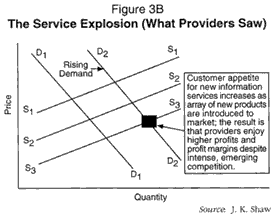
Both proponents and critics of the Telecommunications Reform Act recognize that the industry will experience dynamic shifts in the lines of supply and demand illustrated in the models above. However, those who envision that the market will efficiently decide winners and losers also assume that any organizational turmoil will be minimal within several years following passage of the legislation. Eventually, they contend, this model will define market equilibrium to the advantage of both providers and consumers. As we explore alternative modeling, we will note that this traditional conjecture about market competition constitutes the cutting-edge of interpretative dispute among forecasters. In short, will competition successfully manifest itself in the telecommunications industry as it traditionally has in other sectors of the economy? Or, are there economic characteristics uniquely associated with "information businesses" that alter competitive behavior over the long run?
Implicit in Figures 3A and 3B is the notion that, although the demand function continues to shift to the right, the available supply of telecommunications products/services exceeds rising demand for years to come. Authors of this legislation, and the lobbyists who encouraged them, thus presume that providers will seek to optimize market share in the short run by maximizing supply. Reductions in pricing would ensure nominal market share at the beginning of this competitive wave. Thereafter, providers would be faced with the daunting task of expanding market share in the face of sophisticated players pursuing the same goal.9 Significantly, it is generally estimated that the cost of recruiting a new customer approximates five times the cost of retaining one.10
One may distill the historic evolution of regulation and deregulation, adjusting for time relative to the industry examined, as shown in Figure 4.
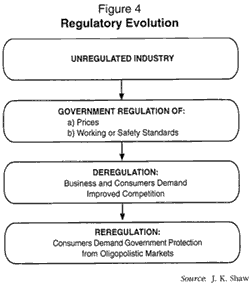
Historically, perceived excesses in free markets precipitated government regulation in the name of protecting the consumer and preserving competition. Such perceptions gave way eventually to attempts at deregulating those same markets as regulation stifled innovation. In the early stages of deregulation, there is a proliferation of competitors that results in declining prices. However, as competitors seek to maximize market share (often through vertical and horizontal integration), oligopolies emerge, thus reinviting government involvement to redress problems of diminished competition. In the case of the airline industry, for example, the second and third stages of this process have taken 15 years to fully unfold. Now, Congress is besieged by complaints from consumers who believe that diminished competition has impaired quality and raised price.
Applying this historical parallel, the telecommunications industry might operate at optimal competitive levels through the year 2010 or so. Thereafter, an oligopolistic pricing structure would emerge from the interaction of a reduced number of players who simply absorbed their competitors. Such horizontal integration would consolidate perhaps 80% of telecom-munications market share among three, four, or five providers.
In the absence of testing this hypothesis, one cannot be sure of the outcome. But, this conjecture is given some credence by similar experiments in deregulation attempted by the federal government since 1978. To argue that historical analogy is a reliable forecasting tool, however, one must consider the unique characteristics of the telecommunications industry.
Several factors distinguish telecommunications from other industries. Certain fields within the industry presently operate on duopolistic, monopolistic, or effective oligopolistic bases. The cellular industry, for instance, consists of two providers per metropolitan area. While emerging competition is coming on-line in the form of SMR and PCS technologies, cellular incumbents nevertheless enjoy intrinsic competitive advantages. The same dilemma confronts long distance providers who seek to enter local loop markets. These patterns are repeated at competitive variance depending on wireline or wireless services.
Additionally, unlike other industries in which products or services are comparatively tangible, the information generated via telecommunications is intangible and portable. Prospectively, every telecommunications service -- voice, data, and image -- presently offered through wireline can be replicated through wireless access. The result is that future commercial transactions are likely to be consummated at any location at any time: we thus make the transition to "anytime, anywhere information." The significance of this development, relative to industry consolidation, lies in the necessity of every wireline provider to augment its product in the form of wireless service. Thus, a substantial fraction of capital investment otherwise exclusively devoted to wireline maintenance is then diverted to wireless infrastructure.
Consider the following model (see Figure 5) in light of the expressed fears of those who believe that deregulation, whatever its short-term benefits, will inevitably impel industry oligopolies. The telecommunications industry, dominated by AT&T through the mid-1980s, enters a period of intense competition during the first five years following passage of the 1996 Act. Beginning early in the 21st century, the industry experiences substantial competition through multiple provider access, but mergers and acquisitions gradually consolidate the market. By 2010, the industry essentially pivots on the market behavior of four or five providers, collectively controlling a minimum of 60% of market share. Approximately a decade will pass before Phase 3 is concretely evident.
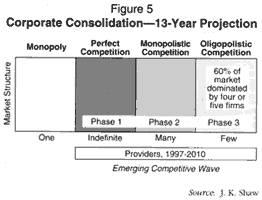
For purposes of the corporate consolidation model, Phase 1 acts merely as a theoretical construct. In practice, it is highly improbable that perfect competition will immediately precede monopolistic competition (many competitors dividing market share on the basis of branding). However, proponents of this model would contend that the greatest opportunities for entrepreneurs will reside within this stage of competitive development.
Given the need of incumbents to diversify services, particularly as wireless products approach maturation in the next century, there exists a natural propensity to purchase already-established firms.11 Quite apart from the need to expand market share, industry consolidation is prompted by the desire of large enterprises to acquire the marketing expertise of young, successful firms. A knowledge of consumer behavior and forecasting will be at a premium for the long-distance giants as well as the Baby Bells.12 The impetus toward horizontal and vertical integration is thus assured.
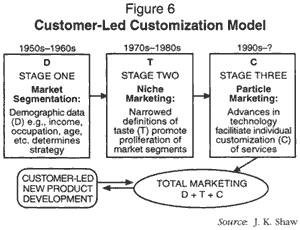
The importance of the recent transition to particle marketing lies in this simple fact: In prior eras, telecommunications providers originated new products and then sought to find or create a market for them. Under the umbrella of particle marketing, providers must first understand the unique needs of individual customers, then attempt to develop services which satisfy those multifaceted needs. Marketing therefore becomes highly complex and fluid. If this development truly manifests itself in the near future, then the industry will be completely reordered -- mass marketing will give way to customized market research, and the success or failure of a firm will hinge on its ability to meet consumer needs on an ongoing basis. In other words, consumers -- households and organizations -- will dictate the terms of the service they receive. "Total marketing" therefore emerges as a model equipped to forecast changing consumer tastes.
If this model represents a valid paradigm for the telecommunications industry over the next decade, then we can infer that providers will attempt to maintain continual, positive, and personal relationships with their customers. As a result, organizational capital once directed to basic research will be diverted increasingly to applied research. A rising fraction of these funds will also be directed to marketing and strategic planning departments, where the firm's primary objective involves gaining a keener understanding of the dynamics of consumer behavior. In short, the customer will tell the industry what to produce and when. If a firm fails to meet that standard, the model implies that we can expect to see a wave of new market entrants, thus generating competition over the long run.
To gauge the credibility of this scenario, uniquely pertinent to the telecommunications industry, consider the recent evolution of the Internet. The Internet, originally created to transmit information between computing networks, was not intended to be a commercial enterprise. In recent years, however, households and businesses are increasingly using this tool for commercial applications. Among those applications are recent innovations in software which permit voice traffic. The result is that telephony providers may be denied the profit incentive to maintain the infrastructure that others are exploiting -- in effect, "free telephony" will eradicate the incentive to maintain current infrastructure. Five years ago, this prospect was unthinkable; now, it is attainable.
The same phenomenon holds for other telecommunications providers as well. In 1994, the FCC granted Interactive and Video Services (IVDS) licenses to investors via auctions. The IVDS industry, as well as the interactive television industry in general, has been stifled in its attempts to bring products to market because of perceived commercial threats implied by Internet development.14 Private enterprise and the investment community are discouraged from generating new product lines in many of these fields because of the emergence of this new platform. Prices of new product lines might contract as innovators learn to substitute the ubiquitous Internet for prior applications. The economics of substitution create, in effect, "free" services for those previously proprietary in nature.
This scenario oversimplifies, of course, the pending development of the telecommunications industry. The fact is that providers in all industries continually seek to exploit the economics of substitution as new markets unfold; this is a traditional tactic of enhancing profit margins. TRA is engineering a "free market environment" at a time when major advances in telecommunications, particularly those sensitive to software applications, make it highly uncertain as to what new ventures are likely to be successful. The risk of excess supply, based on innovations which cannot be forecast, exists at any phase of the production/sales chain. If risk can no longer be calibrated, if prices might implode based on sudden overcapacity, have we put the industry at great long-term risk? That is the message implicit in the model shown in Figure 7.
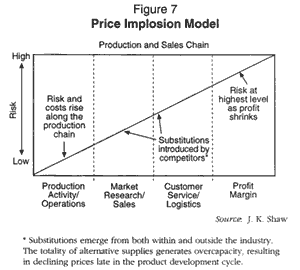
The model suggests that competitive threats surfacing from outside the industry, spurred by technological innovation, will influence the outline of future profit margins. Typically, a company will concern itself only with those innovations introduced by competitors from within the industry itself. In the case of telecommunications, however, new supply by traditional competitors is reinforced by additional services that are not susceptible to traditional forecasting. The result is that the firm which assumes the cost of new product development is sometimes denied the profits that would otherwise accrue. Prices fall or collapse, reducing profit margins proportionately.
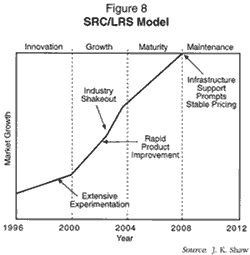
We note in Figure 8 the instability associated with short-term innovations in telecommunications. The proliferation of new entrants, accompanied by uncertainty and risk in infrastructure maintenance, translates into an industry shakeout before 2005. (Empirical evidence suggesting this timeframe is supplied by the experience of airline deregulation in the years immediately following 1978.) The model holds that long-term stability will manifest itself by the year 2008, however. It is during this period that risk diminishes as new infrastructure providers finally stabilize the economic environment. Put another way, the proliferation of service providers in the early years of deregulation is followed by the intervention of capital-intensive wireline maintenance companies. The logical candidate for wireline support during this period is the electric utility: These providers, already facing emerging deregulatory efforts by the states, will seek out new markets where their knowledge of state-of-the-art infrastructure can be readily exploited. The model implies that, by 2008, a vacuum in infrastructure maintenance will invite electric utilities to enter the competition.
Once dismissed as pure fantasy, a scenario in which public utilities enter and stabilize the telecommunications industry is now embraced by many providers. By entering the field of infrastructure support, electric utilities effectively permit other telecommunications companies to pursue diversified strategies and newly-emerging markets, both domestic and international.15
It should also be noted that models serve three discrete functions: